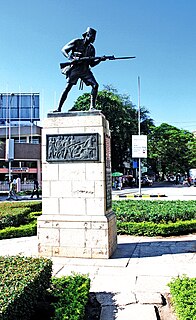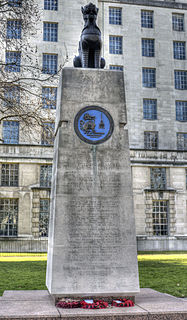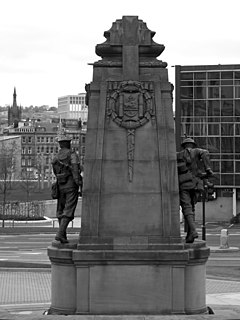
The Machine Gun Corps Memorial, also known as The Boy David, is a memorial to the casualties of the Machine Gun Corps in the First World War. It is located on the north side of the traffic island at Hyde Park Corner in London, near the Wellington Arch, an Equestrian statue of the Duke of Wellington, the Royal Artillery Memorial, the New Zealand War Memorial, and the Australian War Memorial.

The Askari Monument or Dar es Salaam African Memorial in Kivukoni Ward in Ilala District of Dar es Salaam, Tanzania, is a memorial to the askari who fought in the British campaign against the German Army in East Africa in World War I. It was unveiled in 1927. The monument is located at the centre of a roundabout on Samora Avenue at the perpendicular junction to Maktaba Street and Azikiwe Street, a place that reportedly also marks the exact centre of downtown Dar es Salaam.

The National Submariners' War Memorial is a war memorial on the Victoria Embankment in London, England, between Waterloo Bridge and Blackfriars Bridge. The memorial is also referred to as the National Submarine War Memorial, the National Submarine Memorial, the Submarine War Memorial and the Submariner Memorial. It commemorates the Royal Navy submariners who died in the First and Second World Wars. The Royal Navy Submarine Service had 57 operational vessels at the start of the First World War in 1914, but expanded to 137 vessels by the time the war ended in 1918, with another 78 under construction. During the war, 54 of its submarines were sunk, and over 1,300 Royal Navy submariners were killed. The memorial is a Grade II* listed building, and it is the focal point of a special memorial walk and laying of wreaths held each year by submariners on the Sunday preceding Remembrance Sunday.

The Old Steine Gardens in Brighton, Brighton and Hove, East Sussex, England, adjacent to the Old Steine thoroughfare, are the site of several monuments of national historic significance.

The Royal Fusiliers War Memorial is a memorial in London, dedicated to the members of the Royal Fusiliers killed in the World Wars, Russian Civil War and subsequent conflicts, along with members of a number of London Regiment battalions killed in the First World War. It consists of a bronze statue on a 16.5 feet (5.0 m) pedestal made of Portland stone.

Macclesfield Cenotaph is a World War I memorial in Park Green, Macclesfield, Cheshire, England. It was unveiled in 1921, and consists of a stone pillar and pedestal and three bronze statues. One statue is that of a mourning female, and the others comprise Britannia laying a wreath over a soldier who had died from gassing, an unusual subject for a war memorial at the time. The memorial is recorded in the National Heritage List for England as a designated Grade II* listed building.

Moulton War Memorial stands in Main Road, Moulton, Cheshire, England. It consists of a marble statue of a soldier standing on a sandstone pedestal, and is surrounded by a wrought iron fence. The memorial was designed by Samuel Welsby, and unveiled in 1920. It is recorded in the National Heritage List for England as a designated Grade II listed building.

The Edith Cavell Memorial is an outdoor memorial to Edith Cavell by Sir George Frampton, in London, United Kingdom. The memorial is sited in St Martin's Place, beside the A400, just outside the northeast corner of Trafalgar Square, north of St Martin-in-the-Fields, east of the National Gallery and the National Portrait Gallery, and south of the London Coliseum. The site is adjacent to the first headquarters of the British Red Cross, originally located at 7 St Martin's Place.

The Morley War Memorial is a British national war memorial situated in Scatcherd Park, Morley, Leeds, England. Sculpted by Walter Henry Gilbert and cast by H. H. Martyn and Co., it was unveiled 21 May 1927 by Alderman Joseph Kirk and accepted by Mayor Alderman Thomas Marshall. The war memorial was added to the National Heritage List for England on 17 June 1986 as a Grade II listed structure.

A life-size bronze statue of Jan Smuts by the British artist Jacob Epstein stands on the north side of Parliament Square in London, United Kingdom, between a statue of Lord Palmerston and a statue of David Lloyd George.

The Cavalry of the Empire Memorial, also known as the Cavalry Memorial, is a war memorial in Hyde Park, London. It commemorates the service of cavalry regiments in the First and Second World Wars. It became a Grade II listed building in 1987, and was promoted to Grade II* in November 2014.

The Chindit Memorial is a war memorial in London, England, that commemorates the Chindit special forces, which served in Burma under Major General Orde Wingate in the Second World War. The memorial was erected in Victoria Embankment Gardens in 1990, near the Ministry of Defence headquarters, and also commemorates Wingate, who died on active service in Burma in 1944. It became a Grade II listed building in August 2020.

Mells War Memorial is a First World War memorial by Sir Edwin Lutyens in the village of Mells in the Mendip Hills of Somerset, south-western England. Unveiled in 1921, the memorial is one of multiple buildings and structures Lutyens designed in Mells. His friendship with two prominent families in the area, the Horners and the Asquiths, led to a series of commissions; among his other works in the village are memorials to two sons—one from each family—killed in the war. Lutyens toured the village with local dignitaries in search of a suitable site for the war memorial, after which he was prompted to remark "all their young men were killed".

St Saviour's War Memorial is a war memorial on Borough High Street, in the former parish of Southwark St Saviour, to south of the River Thames in London. It became a Grade II listed building in 1998 and was upgraded to Grade II* in 2018.

Runcorn War Memorial was built to commemorate the servicemen of Runcorn lost in active service in the First World War. It was unveiled on Remembrance Sunday 1920 at 3:30pm, beginning a tradition of afternoon services. In 1948, the memorial was rededicated and the names of those lost in the Second World War were added. An inscribed stone was added later with the names of those lost in subsequent conflicts.

The Royal Artillery Boer War Memorial is located on the south side of The Mall in Central London, close to the junction with Horse Guards Road at the northeast corner of St James's Park. Unveiled in 1910, it marks the deaths of the 1,083 soldiers of the Royal Artillery who died in the Second Boer War from 1899 to 1902 It has been a listed building since 1970.

The Dulwich College War Memorial is located at the eastern front of Dulwich College on College Road in Dulwich in the London Borough of Southwark. It commemorates the alumni of the college who died in both the First and Second World Wars. The memorial was designed by W. H. Atkin-Berry, an alumnus of the college. It was unveiled on 17 June 1921, the Dulwich College Founder's Day, by Major General Sir Webb Gillman, and dedicated by the Dean of Durham, James Welldon. Gillman was an alumnus of the college, and Welldon had served as Master of Dulwich College from 1883 to 1885. It has been Grade II listed on the National Heritage List for England since May 2010. The heritage listing places the memorial within a "visual and contextual relationship" with the Grade II* listed Main College building.

Bradford War Memorial commemorates the 37,000 men the English city of Bradford who served in the British Armed Forces in the First World War. Many of the 5,000 dead had served in the two Bradford Pals battalions and were killed on 1 July 1916, the first day of the First Battle of the Somme. The stone pylon with bronze statues was unveiled on 1 July 1922, in Victoria Square, beside Prince's Way, to the northeast of the Grade II listed Queen Victoria Memorial. A bronze plaque was added after the Second World War, and the memorial also commemorates later conflicts. It stands between the National Media Museum and Alhambra Theatre, Bradford, and was Grade II listed in 2016.

Twickenham War Memorial, in Radnor Gardens, Twickenham, London, commemorates the men of the district of Twickenham who died in the First World War. After 1945, the memorial was updated to recognise casualties from the Second World War. The memorial was commissioned by Twickenham Urban District Council in 1921. It was designed by the sculptor Mortimer Brown, and is Brown's only significant public work. The memorial is unusual for its representation of a jubilant soldier returning home. It became a Grade II* listed structure in 2017.

Kingston upon Thames War Memorial, in the Memorial Garden on Union Street, Kingston upon Thames, London, commemorates the men of the town who died in the First World War. After 1945, the memorial was updated to recognise casualties from the Second World War. The memorial was commissioned by the town council and was designed by the British sculptor Richard Reginald Goulden. The memorial includes a bronze statue of a nude warrior, carrying a flaming cross and wielding a sword with which he defends two children from a serpent, erected on a granite plinth, with bronze plaques listing the names of the dead. Goulden designed a number of such allegorical memorials, including others at Crompton, Greater Manchester, and Redhill, Surrey. The Kingston memorial was designated a Grade II listed structure in 1983. This was revised upwards in 2016 to Grade II*, denoting a building or structure of particular importance.























